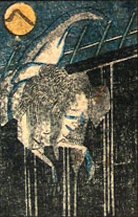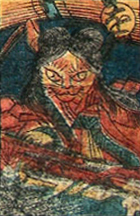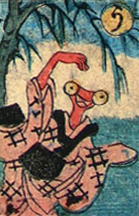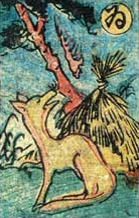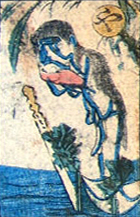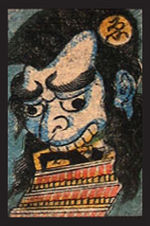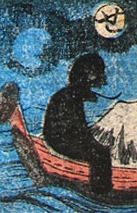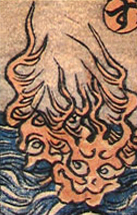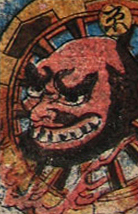Still working to recover. Please don't edit quite yet.
Obake karuta
Obake karuta, as it is popularly known, or Yokai karuta as it is referred to by scholar[1] is a form of the Japanese card game Karuta. Karuta (ã‹ã‚‹ãŸ) derives from the Portuguese word meaning "card", carta.[2] Obake karuta was created in the Edo period and remained popular through the 1910s or 1920s.[3]
The basic idea of any karuta game is to be able to quickly determine which card out of an array of cards is more advantageous in combination with the cards currently held, and then to grab it before it is grabbed by an opponent. Yomifuda (èªæœ) or "reading cards", are read aloud to inform the players of the goal that they can achieve by collecting the torifuda (å–ã‚Šæœ) "grabbing cards."
Karuta is often played by children at elementary school and junior high-school level during class, as an educational exercise. Although several kinds of Karuta games are described below, in reality any kind of information that can be represented in card form can be used including shapes, colours, words in English, small pictures and the like.
Obake karuta is an early example of the common Japanese fascination with classifying monsters and creating new ones. The game is one of the earliest attempts by Japanese companies to categorize legendary creatures, label them, define them, and subsequently market them. As such, it is a precursor to the Godzilla films of the 1950s and later. Even more closely, obake karuta resembles the Yu-Gi-Oh! or Pokémon Trading Card Game, which also involves collecting cards that represent fabulous creatures. In fact, many Pokémon were designed specifically after creatures from Japanese mythology.[3]
Each playing card in the deck features a character from the hiragana syllabary and a creature from Japanese mythology; in fact, obake karuta means ghost cards or monster cards.[3] Success requires knowledge of Japanese mythology and folklore as players attempt to collect cards that match clues read by a referee. The player who accumulates the most cards by the end of the game wins.
The two types of karuta cards that are most often seen are the "iroha-garuta" and "uta-garuta".
Anyone who can read Wikipedia:hiragana can play "iroha-garuta" (ã„ã‚ã¯ãŒã‚‹ãŸ). In this type, a typical torifuda features a drawing with a Wikipedia:kana at one corner of the card. Its corresponding yomifuda features a Wikipedia:proverb connected to the picture with the first syllable being the kana displayed on the torifuda. Monster cards were a Iroha game, with a kana clearly visible in one of the top corners.
In "Wikipedia:uta-garuta", players try to find the last two lines of a tanka given the first three lines. It is often possible to identify a poem by its first one or two syllables. The poems for this game are taken from the Hyakunin Isshu and are traditionally played on New Year's Day.
Citations[edit]
- ↑ Michael Dylan Foster (1955). Pandemonium and parade: Japanese monsters and the culture of yÅkai, University of California Press.
- ↑ Karuta Asahi-net
- ↑ 3.0 3.1 3.2 Pflugfelder, Gregory M. "Display Case 8: Monster Merchandise (II)". Godzilla Conquers the Globe: Japanese Movie Monsters in International Film Art. Accessed 11 March 2006.
| This article contains content from Wikipedia. Current versions of the GNU FDL article Obake karuta on WP may contain information useful to the improvement of this article | WP |





